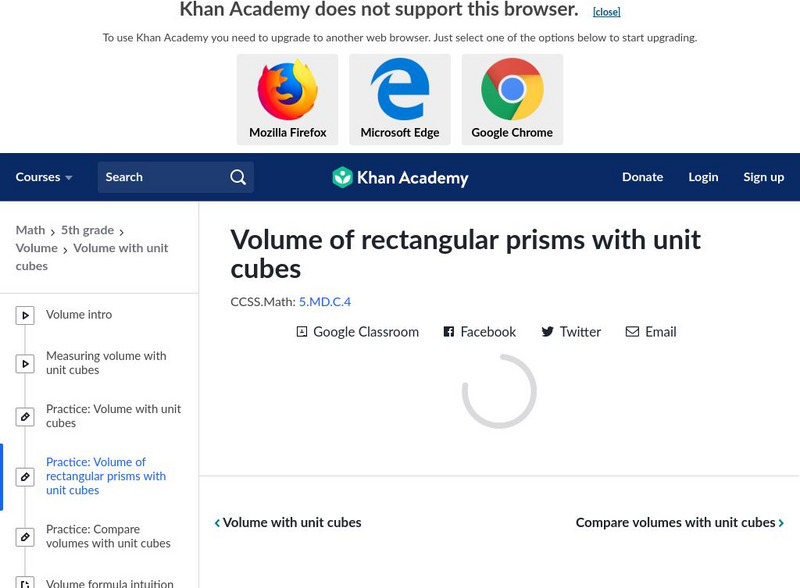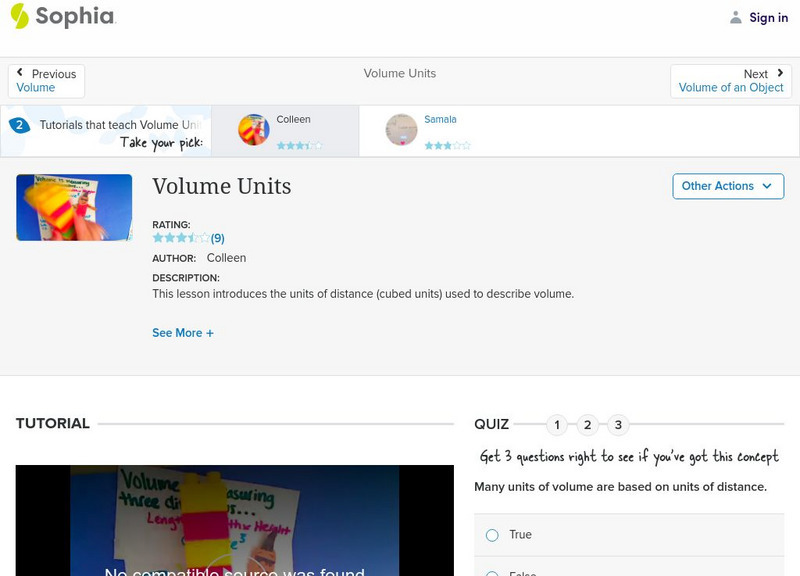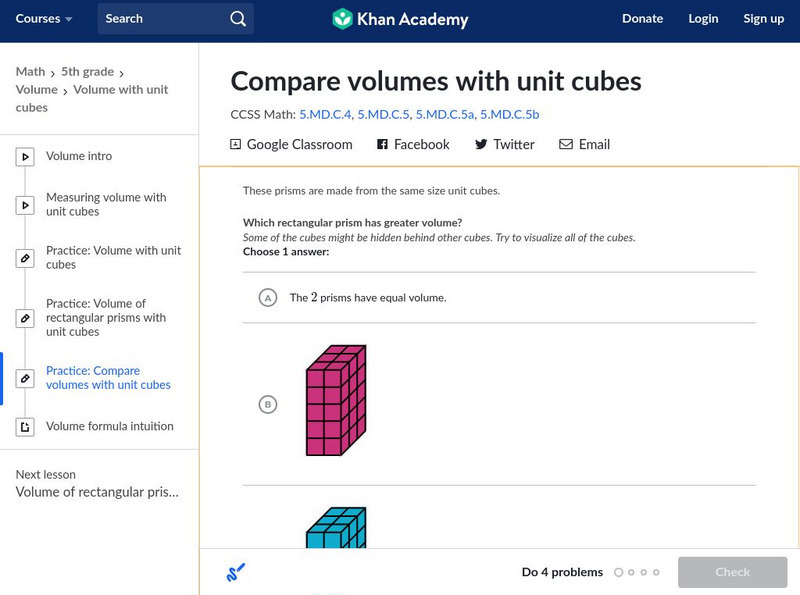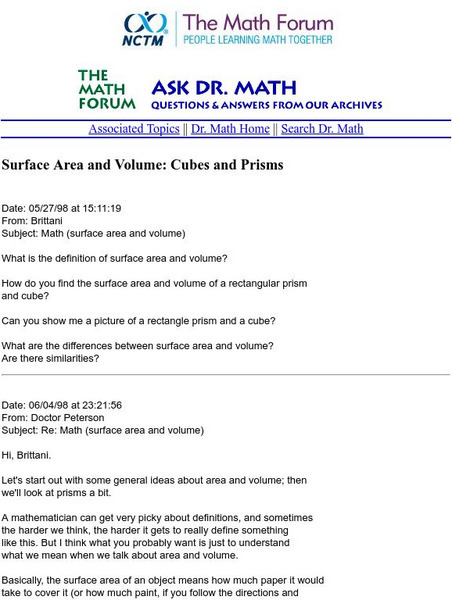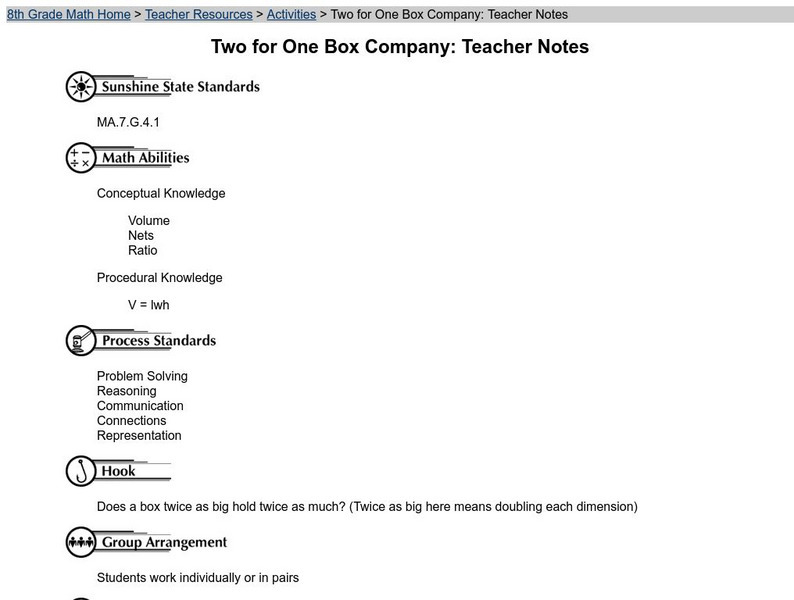Curated OER
Rep Tiles
Third graders use pattern blocks of one shape at a time to try to create a similar shape. They compare the perimeter of the new figure with the perimeter of the original shape and look for a pattern. Students use the pattern to predict...
Curated OER
Change It
Fourth graders expand their knowledge about how the physical properties of a substances can be changed. They are given multiple opportunities, using first-hand experiences and familiar objects in different contexts, to identify...
Curated OER
Polyhedra
Students analyze convex polyhedra through hands on methods. For this geometrical shapes lesson, students construct paper models of convex polyhedra and identify the different properties including the number of sides, faces and edges.
Curated OER
Analyzing 3-D Shapes and 2-D Representations
Students can analyze 3-D objects better with actual physical models and by also drawing 2-D representations of them.
Curated OER
Math - "Solid Shapes" - Comparing 3-D Objects
In this geometry worksheet, students learn about 3-D objects and how to describe them. They then answer 10 questions using the information they learned. The answers are on the last page.
Curated OER
Why Are Cells So Small?
Young scholars examine the relationship between cell surface area and the ability of materials to diffuse through a cell. They participate in an experiment in which they determine which materials diffuse easier than others. They...
Curated OER
Commutative Property
First graders investigate the Commutative Property of Addition. It is introduced using models such as students, counters, balances and dominoes. They discover the order of the numbers in an addition sentence does not change the result...
Curated OER
Sea Ice and Sheet Ice Melting Experiment
Students observe the change in water level as a result of melting sea ice and melting sheet ice.
Curated OER
Density: Float or Sink
Young scholars discover density. For this density lesson, students discover the properties of objects that allow them to float or sink in water.
Curated OER
Density and Buoyancy Lesson Plan
Students investigate why some objects float or sink in water. In this physics lesson, students calculate the density of clay ball using a mathematical equation. They write a complete lab report about the experiment.
Curated OER
Science Test B-Grade 5
In this grade 5 science test worksheet, 5th graders complete a 30 question multiple choice quiz covering a variety of grade 5 concepts.
Curated OER
Air: It's a Gas!
Students investigate the properties of air through hands-on activities in conjunction with the demonstrations in a 3-2-1 Contact Video.
Curated OER
Problem-Solving Application: Use Formulas: Practice
In this formula worksheet, students use formulas to solve 5 word problems, showing their work. Houghton Mifflin text is referenced.
Curated OER
MEANINGFUL METRICS with DRAMATIC DEMONSTRATIONS
Tenth graders study the metric system. In this metric lesson students complete a lab activity and several metric worksheets.
Khan Academy
Khan Academy: Volume of Rectangular Prisms With Unit Cubes
Find volume of 3-dimensional figures by counting unit cubes. Students receive immediate feedback and have the opportunity to try questions repeatedly, watch a video or receive hints.
Sophia Learning
Sophia: Volume Units
This lesson introduces the units of distance (cubed units) used to describe volume. Students watch a video tutorial and then can take an online quiz.
Khan Academy
Khan Academy: Compare Volumes With Unit Cubes
Recognize volume as an attribute of solid figures and understand concepts of volume measurement. Students receive immediate feedback and have the opportunity to try questions repeatedly, watch a video or receive hints.
Khan Academy
Khan Academy: Comparing Volumes With Unit Cubes
In this exercise, students practice comparing volumes with unit cubes. Students receive immediate feedback and have the opportunity to get hints and try questions repeatedly.
PBS
Nova Online: How Many Pearls? A Weight & Volume Game
This interactive game has students apply skills in estimation, measurement, and basic addition using pearls. Students are asked to estimate the number of pearls in a treasure chest by making predictions and using number sense. The skills...
BBC
Bbc Bitesize: Volume
Pick up some valuable pointers on how to figure out the volume of various shapes. When you finish working your way through the pages you can take an online "Test Bite" and check your understanding.
National Council of Teachers of Mathematics
The Math Forum: Ask Dr. Math: Surface Area and Volume:prisms
This site from the Drexel University is a detailed explanation of area and volume for those who have trouble with the concept and need an explanation of how they are related and their differences, and other basic concepts for a clear...
Illustrative Mathematics
Illustrative Mathematics: 5.md Box of Clay
This task provides an opportunity to compare the relative volumes of boxes in order to calculate the mass of clay required to fill them. Aligns with 5.MD.C.
Ducksters
Ducksters: Kids Math: Finding the Volume of a Cube or Box
Learn how to solve the volume of a cube or box on this site. See how the formula is used to find the volume of the shape.
University of South Florida
Fcat: Two for One Box Company: Teacher Notes
At this site students use proportions to explore how volume is effected by dimension changes. This hands-on activity can be done individually or in pairs.














